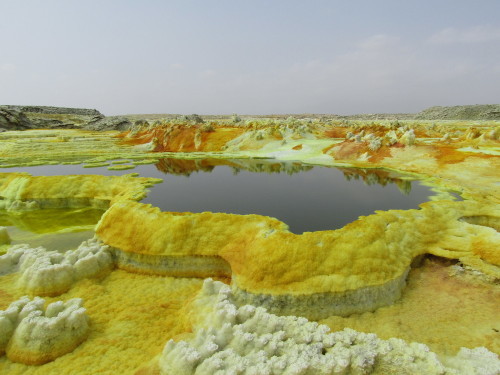#Danakil Desert
Text
Situated off the coast of Brazil, Snake Island is home to some of the world’s deadliest snakes. The island is off-limits to visitors, as it is home to the golden lancehead viper, which is one of the most venomous snakes in the world.
Although there is no confirmed number, it is estimated that there are around 5,000 snakes on the island. That means there’s roughly one snake for every square meter of land. In other words, you’re never more than a few feet away from a lethal snake when you’re on Snake Island.
0 notes
Text
Researching a fish I heard about on a podcast and found these beauties

THIS IS SO COOL, I went and started reading about these guys and I'm going RABID, I FUCKING LOVE FISH THAT EVOLVE AND ADAPT TO A VERY SMALL AND ISOLATED ENVIRONMENT. LOOK AT THIS LAKE, THEY LIVE IN A FUCKING PUDDLE.
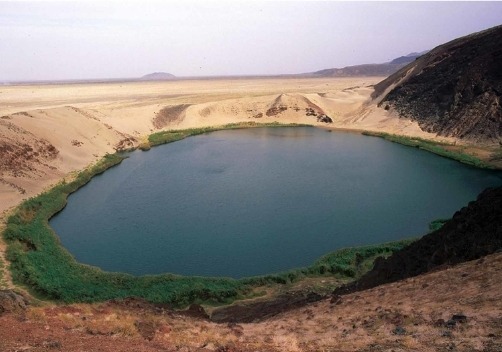

Also GOD I love cichlids. They have so many Shapes and they're all so perfect
#submission#danakili dinicolai#ethiopian wildlife#ethiopian desert fish#danakil#description in alt text#full frontal fish
59 notes
·
View notes
Text
The Danakil Depression is a low-lying area located in northeastern Ethiopia, near the border with Eritrea. It is known for its extreme temperatures, high levels of salt, and unique geological features. The Danakil Depression is one of the hottest and most arid places on earth, with temperatures reaching up to 140 degrees Fahrenheit (60 degrees Celsius). The Danakil Depression is also home to several active volcanic fields, including the Erta Ale volcano, which is one of the few continuously active volcanoes in the world. The area is also known for its salt mines, which have been in operation for thousands of years and are still worked by local Afar people. The salt mines are a major source of income for the region. =======================
VIDEO URL : https://youtube.com/shorts/GTSV_atpOdo
CHANNEL URL : bit.ly/3GCRL7y FOLLOW US : https://linktr.ee/Travel.store24
==========================
MUSIC BY : Pixabay
#hottestplaceonearth #danakildepression #ethiopiadangerouspart
#danakil depression#afar desert ethiopia#hottest place on earth#afar region ethiopia#ethiopia dangerous part#tigrai region ethiopia
0 notes
Text
Back to watching The Terror
Something that this show is absolutely getting right is the sheer desolate nothingness of the arctic
There is nothing there. No plants. No grass, no trees, no moss. Nothing. Just barren stone and frozen dirt. Any animals you might encounter are practically meaningless to you. So far down in the water they might as well not exist, or glimpsed at a distance on far away ice floes. The nearest we can possibly come to experiencing just how much nothing is in the arctic is to go to the most inhospitable desert you can find. The Danakil, the middle of Death Valley. Someplace like that. Where there's nothing but sand and stone and blistering heat. And then we would have an INKLING of what the arctic is like.
32 notes
·
View notes
Text
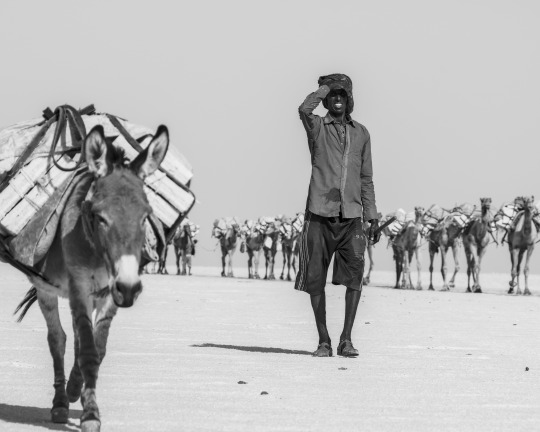
Salt route, Danakil desert, 2018
#travel#ethiopia#africa#original photographers#photographers on tumblr#monochrome#salt route#cameleer#b&w photography#b&w street photography#donkey#caravan
47 notes
·
View notes
Note
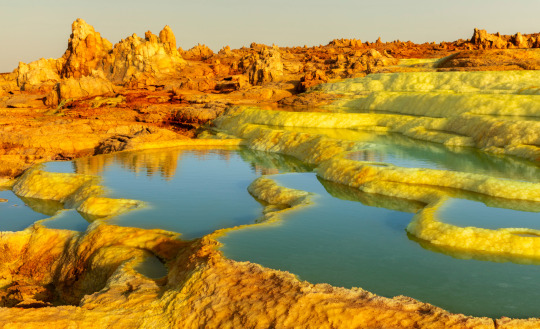
Danakil Desert
Ethiopia (mostly)
8 notes
·
View notes
Photo

by Exodus Travels - Reset your compass on Flickr.Salt and sulphur geysers at Dallol volcano - Danakil desert, Ethiopia.
9 notes
·
View notes
Text
Discover the Hidden Gems of Ethiopia: A Cultural Expedition
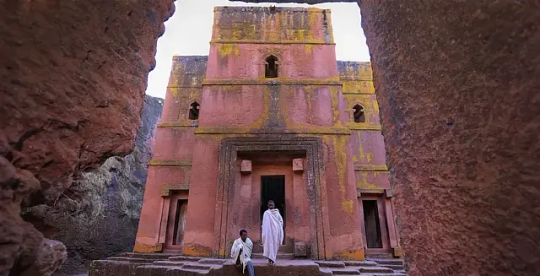
Discovering Ethiopia
Ethiopia is a country located in the northeastern part of Africa and it is known for its rich history and cultural diversity. It is bordered by six neighbors: Eritrea to the north, Djibouti to the northeast, Somalia to the east, Kenya to the south, South Sudan to the west, and Sudan to the northwest.
The country has a population of over 100 million people and is home to more than 80 ethnic groups who speak different languages. Ethiopia has a long history dating back thousands of years; it was one of the oldest civilizations in Africa and developed its own unique script and calendar.
The country is also famous for being the only African nation that successfully resisted colonization by European powers in modern times.
Despite its long-standing place in history, Ethiopia remains relatively unknown to many tourists. However, its unique blend of traditions and modernity has recently gained attention from international travelers seeking an authentic cultural experience. With so much to see and discover, Ethiopia is quickly becoming a must-visit destination for those looking for something different.

Hot springs in the Danakil Depression in Ethiopia's Afar region. Photo by Jorge Tung. Unsplash.
Ethiopia's Unique Climate
The country experiences two main seasons- the rainy season and the dry season. The rainy season runs from June to September, while the dry season lasts from October to May.
The highlands of Ethiopia experience a temperate climate due to their altitude, with temperatures averaging between 10°C and 20°C throughout the year.
However, as one moves towards the lowlands or deserts (like the Danakil Depression) temperatures can rise up to 50°C during the day whilst dropping significantly at night due to the desertification.
The Rift Valley region also has unique weather conditions that are hot and humid throughout most parts of the year.
If you're looking to explore the Simien Mountains National Park or trekking in Lalibela, then the dry season months between October and March would be an ideal time for you.
During these months, the days are warm with clear blue skies which make it perfect for outdoor activities such as hiking and photography.

Australopithecus afarensis fossil hominid, the Lucy skeleton, from the Hadar area, Afar Triangle, northern Ethiopia. Photo by James St. John. Flickr.
The Amazing History of Ethiopia
Ethiopia has a rich and diverse history that spans thousands of years. The country is believed to be one of the oldest civilizations in the world, with evidence of human habitation dating back to around 4 million years ago.
The earliest known human ancestor, "Lucy," was discovered in Ethiopia in 1974 and is believed to be over three million years old. The region was also home to some of the earliest forms of agriculture, with crops such as coffee and teff being cultivated there for thousands of years.
The early history of Ethiopia is shrouded in mystery, but it is known that several powerful kingdoms emerged in the region during ancient times. One such kingdom was Aksum, which rose to prominence around 100 AD.
Aksum was a major center for international trade and played an important role in spreading Christianity throughout Africa. Another notable kingdom was Abyssinia, which emerged around 1270 AD and lasted until the late 20th century. This kingdom played a key role in Ethiopian politics and culture for centuries.
Today, visitors can still catch glimpses into Ethiopia's past through its architecture, art, and cultural traditions.
Top Attractions in Ethiopia
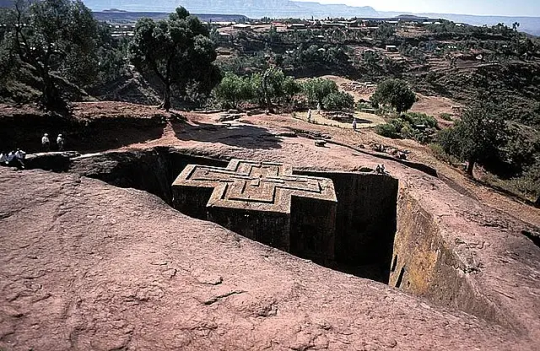
Bete Giyorgis, the Church of St. George, in Lalibela, Ethiopia. Photo by Jialiang Gao. Wikimedia.
Lalibela
One of the most popular attractions in Ethiopia is Lalibela, a small town known for its incredible rock-hewn churches. These beautifully crafted structures were carved out of solid rock over 800 years ago and remain some of the most impressive examples of religious architecture in the world today.

Simien Mountains, Kingdom Of Gondar. Photo by Rod Waddington. Flickr.
Simien Mountain National Park
The Simien Mountains in Ethiopia are a stunning natural wonder, recognized as a UNESCO World Heritage Site. Located in the northern part of Ethiopia, the mountain range stretches for about 160 kilometers and is home to a diverse array of flora and fauna.
The Simien Mountains are known for their deep gorges and dramatic waterfalls that cascade down rocky cliffsides.
Beyond its natural beauty, the Simien Mountains are also home to unique wildlife such as Gelada baboons, Ethiopian wolves, and Walia ibexes – all of which can only be found within this area.

Great Rift Valley, Ethiopia. Photo by Scott Edmunds. Flickr.
Rift Valley
This geological feature stretches approximately 6,000 km from Syria to Mozambique and bisects Ethiopia into two halves.
The Ethiopian Rift Valley is home to several lakes, hot springs, volcanoes, and unique flora and fauna that form a rich ecosystem.
The Great Rift Valley was formed by the movement of tectonic plates over millions of years. As the plates moved apart, deep fissures were created in the Earth's crust, forming valleys where water collected and created lakes.
In Ethiopia's case, there are seven crater lakes within walking distance from each other in the region around Bishoftu city.
These lakes provide an excellent opportunity for visitors to experience nature at its best while enjoying activities such as birdwatching or boating.

Hamer in Logara, near Turmi, Ethiopia. Photo by Alfred Weidinger. Flickr.
The Rich Culture of Ethiopia
This East African nation has over 80 ethnic groups, each with its unique customs, language, and way of life. Its history dates back over 3,000 years and is rich with mythology and legend. The country boasts many archaeological sites that reveal its long-standing civilization.
Ethiopian culture is vibrant and colorful, celebrating everything from religious festivals to traditional dances.
One of Ethiopia's most significant cultural treasures is its religious heritage. Ethiopian Orthodox Christianity has been practiced for sixteen centuries and has greatly influenced the country's art, music, literature, and architecture. The churches carved out of solid rock in Lalibela are a testament to this rich tradition.
The Ethiopian Orthodox Church plays a significant role in the country's culture. Its practices are deeply intertwined with Ethiopian traditions; many religious celebrations involve music, dance, and feasting.
Despite Ethiopia's deep roots in ancient culture, it remains a modern nation with thriving cities like Addis Ababa. The capital city blends traditional and contemporary cultures through its architecture and cuisine making it an exciting destination for travelers seeking to explore both sides of this fascinating country.
Music and dance are also an integral part of Ethiopian culture. Traditional music often features instruments such as the masinko (a one-stringed fiddle) or krar (a six-stringed lyre).
Meanwhile, unique popular dancing styles include eskista (shoulder dancing) or amhara kemis (woven cloth dancing).

Injera with Shiro Wot. Made with Teff flour. Photo by David. Flickr.
People of Ethiopia and their food
Ethiopia is known for its rich history and strong traditions that continue to shape its people's lifestyle today. The majority of Ethiopians belong to various ethnic groups such as the Oromo, Amhara, Tigray, and Somali.
The economy of Ethiopia is largely based on agriculture, which employs over 80% of the population. The main crops grown are coffee, cereals (such as maize and teff), oilseeds (such as sesame and sunflower), pulses (such as beans and lentils), fruits, vegetables, and flowers.
Traditional Teff Flour
Teff flour is a gluten-free flour that grows in Ethiopia, where it has been used for centuries as a staple food. It is made from the tiny seeds of the teff plant, which are ground into a fine powder. Teff flour has a slightly nutty taste and can be used to make a variety of dishes, including bread, pancakes, and porridge.
One of the main benefits of teff flour is its high nutritional value. It is rich in protein, fiber, iron, calcium, and other essential vitamins and minerals. This makes it an excellent choice for people who are looking for healthy alternatives to wheat-based flour.
Additionally, because it is gluten-free, teff flour can be enjoyed by those with celiac disease or gluten intolerance without causing any adverse reactions.
Injera is the most popular food in Ethiopia. It is a flatbread made from teff flour and has a sourdough taste to it. Injera can be eaten on its own or used as an accompaniment to different stews, curries, and vegetables.
Wat is another famous Ethiopian dish that consists of meat or vegetable stew accompanied by injera bread. Wat comes in different varieties each with their distinct flavor profiles depending on the type of meat or vegetables used in preparing it.
Aside from agriculture, there are other industries that provide employment for Ethiopians. One such industry is textiles, which produces clothing made from cotton grown in the country. Ethiopia's leather industry is also growing rapidly due to the high demand for quality leather products worldwide. Also, the constru
ction sector has been booming in recent years due to increased government investment in infrastructure projects like building roads and accommodation.
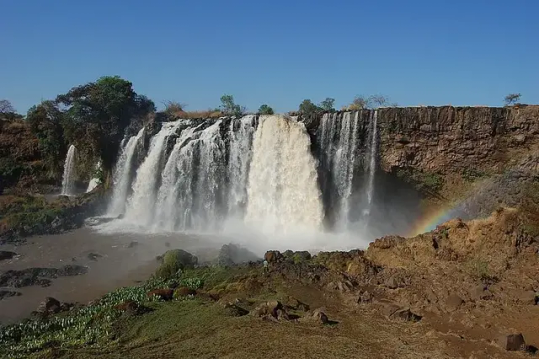
Blue Nile falls. Photo by Katie Hunt. Flickr.
Conclusion
Ethiopia is a country that has much to offer to visitors. From its rich cultural heritage, breathtaking landscapes, and wildlife, there is always something new to discover in this magnificent nation.
One thing that stands out about Ethiopia is the warmth of its people. Ethiopians are friendly, hospitable, and always willing to help visitors navigate through their cities.
You will also find a variety of delicious traditional dishes such as injera (a sourdough flatbread) served with a variety of stews known as wats. The music and dance performances are also unique experiences that showcase the diverse cultures found throughout Ethiopia.
Ethiopia is a country known for its diversity of wildlife, including numerous species of birds. With more than 800 identified bird species, Ethiopia's avifauna is one of the richest in Africa and the world.
The country's varied topography, ranging from high mountains to lowland plains, has created diverse habitats that support different bird communities.
With so much to see and discover, Ethiopia is a brilliant destination for those looking for something different.
Sources: THX News & Ethiopia.
Read the full article
#Africa#AfricanTravel#Aksum#EastAfrica#Ethiopia#Ethiopia'sRainySeason#HiddenGemsofEthiopia#HistoryofEthiopia#Lalibela#RiftValley#SimienMountainNationalPark#Travel#Wat
6 notes
·
View notes
Text
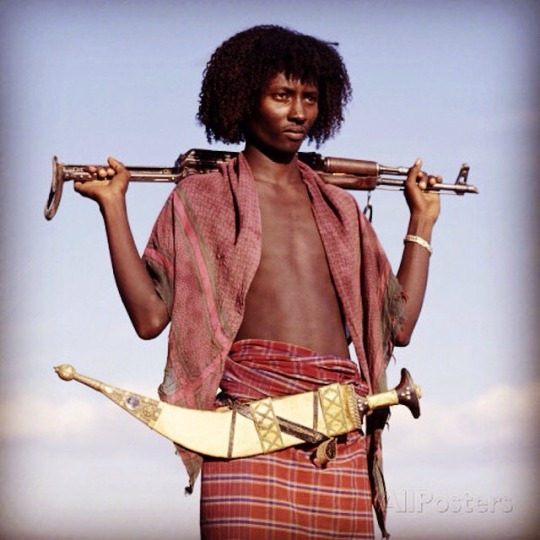


The Afar (Danakil) claim to be descendants of Ham (Noah’s son). They are located in the East African countries of Djibouti, Ethiopia, and Eritrea. They prefer to be known as the Afar, since the Arabic word “danakil” is an offensive term to them. They are a proud people, emphasizing a man’s strength and bravery. Prestige comes from killing one’s enemies.
The Afar consist of two subgroups: the Asaemara (“red ones”), who are the more prestigious and powerful nobles living primarily in the area of Assayita; and the Adaemara (“white ones”), who are the commoners living in the desert areas. Those who live in the desert inhabit one of the most rugged regions in the world, known as the Afar Plain or the Danakil Desert. One area, called the Danakil Depression, consists of a vast plain of salt pans and active volcanoes. Much of it lies 200 feet below sea level and has daily temperatures as high as 125 degrees F. The average yearly rainfall is less than seven inches
What Are Their Lives Like?
Most of the Afar are nomads who herd sheep, goats, cattle, and camels. A man’s wealth is measured by the size of his herds.
Not all of the Afar are herdsmen. Many of those who work in the Danakil Depression pry loose slabs of solid salt during the dry season, supplying ready-to-use salt in the form of crude blocks. Some of them live in apartment buildings in the country’s capitol city, Addis Ababa. They remain there year round and work in government jobs such as the Afar broadcasts of the Ethiopian radio station.
Although some Muslims are permitted to have four wives, Afar marriages are usually monogamous. Girls may marry as early as age ten. Marriages between first cousins are preferred, particularly between a man and his father’s sister’s daughter. The night of the full moon is favored for a wedding ceremony, and the presence of someone able to read the Koran is required.
Meat and milk are the major components of the Afar diet. Milk is also an important social “offering”. For instance, when a guest is given fresh warm milk to drink, the host is implying that he will provide immediate protection for the guest. If a person is killed while under the protection of an Afar, his death must be avenged as if he were a member of the clan.
The Afar live in camps surrounded by thorn barricades, which protect them from the attacks of wild animals or enemy tribesmen. Their oval-shaped huts, called ari, are made of palm mats and are easily moved
What Are Their Beliefs?
Early in their history, the Afar were heavily influenced by the Islamic religion; and today, Islam is still held in great esteem. The people do not eat pork and rarely drink alcohol. Those who can afford to do so, make a pilgrimage to Mecca. In addition, many pre-Islamic beliefs and customs are also prevalent among the Afar. They believe that certain trees and groves have sacred powers. They also have various religious rites such as anointing their bodies with ghee (a type of butter). Spirits of the dead are believed to be very powerful, and a “feast of the dead”, called Rabena, is celebrated each year. They also give annual offerings to the sea to ensure safety for their villages. Many people wear protective leather amulets that contain herbs and verses from the Koran.
What Are Their Needs?
Because the Afar are a proud, independent people, they have had a very turbulent history. In recent times, the government has built houses with kitchens and bathrooms – luxuries previously unknown to these nomads.
Only one large river, the Awash, flows through the Danakil Desert. However, it dwindles into a series of lakes before ever reaching the sea. Consequently, there is a great need for pure water sources for the Danakil and their herds. In recent years, they have suffered because of famines and drought.
(BEYOND ENTERTAINMENT:BLOG)
BY: KWESI
3 notes
·
View notes
Text
There's a place in Africa where you can find a river that runs red with blood, trees that drip with poison, and a lake full of deadly acid. It's called the "Valley of Death," and it's one of the most bizarre places on Earth.
The Valley of Death is located in the Danakil Desert of Ethiopia. It's a place where the Earth's crust is so thin that it's constantly bubbling and boiling with molten lava. The heat is so intense that it's impossible for anything to live there.
But somehow, life has found a way.
The trees in the Valley of Death are covered in a red substance that looks like blood. But it's not blood; it's a red sap that oozes from the trees. The sap is so poisonous that it will kill you if you touch it.
The river that runs through the Valley of Death is also red, but it's not because of the sap. The river is red because it's full of iron oxide, which is a rust. The iron oxide gives the river its red color.
But the most bizarre thing in the Valley of Death is Lake Asale.
Lake Asale is a lake of acid. The water is so corrosive that it will eat through your skin if you touch it. The lake is also full of deadly bacteria that can kill you if you drink the water.
Despite all of the dangers, people still live in the Valley of Death. They mine salt from the lake and sell it to make a living.
So if you're ever in Ethiopia, be sure to stay away from the Valley of Death. It's a place where death is just waiting to happen.
1 note
·
View note
Photo
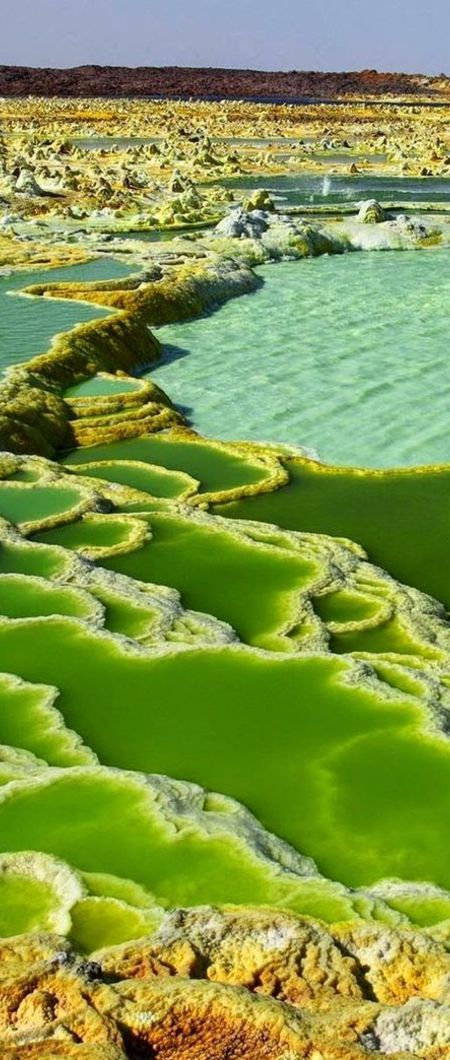
Acid lakes at the Dallol Volcano in Danakil Desert, Ethiopia
Descend into nature's stained glass: Witness the vibrant acid lakes at the Dallol Volcano in Danakil Desert, Ethiopia.
0 notes
Text
Acid lakes at the Dallol Volcano in Danakil Desert, Ethiopia
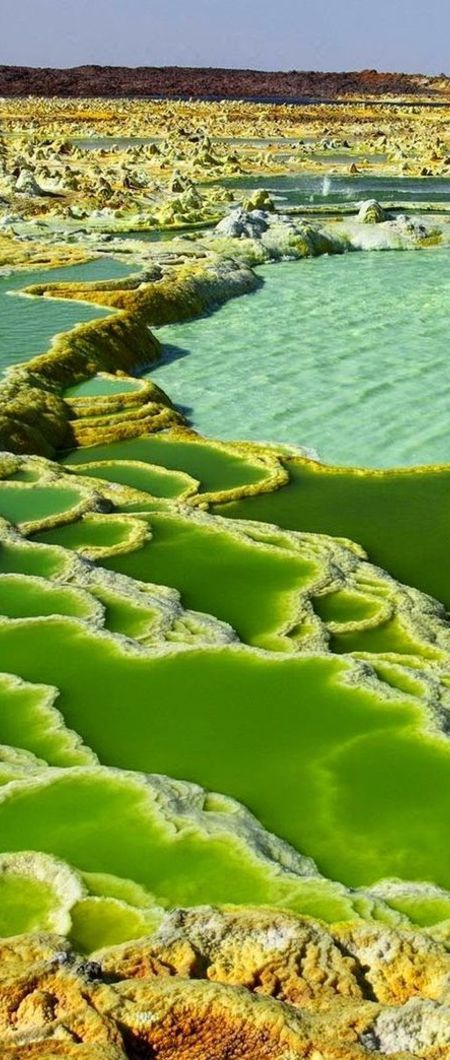
Nature's otherworldly wonder: Discover the fascinating acid lakes of Dallol Volcano in Ethiopia's Danakil Desert, where reality becomes a dream.
0 notes
Text
0 notes
Photo

by Exodus Travels - Reset your compass on Flickr.Salt and sulphur geysers at Dallol volcano - Danakil desert, Ethiopia.
0 notes

